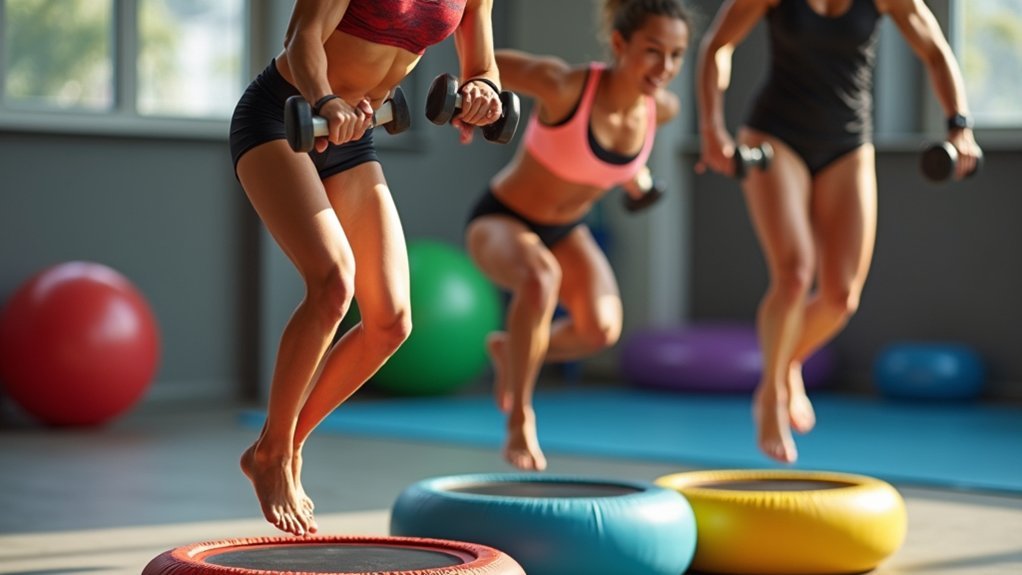Weighted rebounding combines trampoline exercise with resistance training for powerful muscle sculpting. You’ll get maximum results with the upper body circuit (bicep curls, tricep dips), lower body workout (weighted squats, glute activations), full-body techniques (overhead presses with squats), core strengthening routines, and progressive intensity programs. This low-impact approach creates double resistance while reducing joint strain, making it ideal for hypertrophy and endurance. Discover how these five workout styles can transform your physique with less effort than traditional training.
Why Weighted Rebounding Is The Ultimate Muscle Sculptor

While traditional weightlifting has long dominated muscle-building routines, weighted rebounding emerges as a revolutionary approach to sculpting lean, functional muscle. This innovative method creates a double impact effect, where weights experience twice the resistance at the bottom of each bounce, greatly amplifying muscle engagement.
Weighted rebounding revolutionizes muscle building through double impact resistance, amplifying results beyond traditional weightlifting methods.
What makes rebounding uniquely effective is its combination of resistance phases. You’ll experience weightlessness at the top of each bounce—allowing faster fatigue-free repetitions—followed by triple resistance as muscles work against gravity. This continuous tension creates ideal conditions for hypertrophy.
Olympic trainer Harry Schneider validated this approach for elite athletes, recognizing its ability to develop explosive power while strengthening tendons and ligaments. Rebounding engages various muscle groups, including abdominal, leg, buttock, and deep back muscles simultaneously.
You’ll enjoy extensive muscle activation with markedly reduced joint strain compared to ground-based exercises—making it effective for all fitness levels.
Essential Equipment For Effective Weighted Rebounding
Transforming your rebounding routine from basic bouncing to muscle-sculpting workouts requires specific equipment designed to maximize resistance and results.
Choose a rebounder that supports weighted exercise—bungee-cord models offer adjustable tension while commercial-grade options like the Orbit OBT5650SH feature reinforced frames that withstand intense sessions.
The HIIT Bounce Pro’s incline kit creates angled surfaces for targeted muscle engagement.
For resistance, add ankle weights (0.5-2kg) and wrist weights (0.5-1.5kg) to intensify lower and upper body workouts.
Stability tools matter too—look for models with 8-point handlebars for support during weighted squats and non-slip feet to prevent shifting.
Look for rebounders with high weight capacity to ensure safety and durability during weighted exercises.
Track your progress with built-in bounce counters and use included workout apps to master proper form with weights for peak muscle development.
Upper Body Blast: Arms And Shoulders Rebounding Circuit

Ready to take your rebounding workout to new heights? This targeted upper body circuit combines the cardio benefits of rebounding with strength training to sculpt your arms and shoulders in record time.
Your 21-minute circuit includes bicep curls while bouncing, modified tricep dips using the rebounder’s edge, and single-arm overhead presses that engage your core and improve balance. For tricep exercises, focus on keeping your shoulders relaxed to maximize effectiveness and reduce strain.
Add high wide rows and lateral raises to complete the shoulder-defining sequence.
Grab your rebounder and select varying dumbbell weights to adjust intensity. Always begin with a proper warm-up and maintain correct posture during exercises.
Remember to breathe rhythmically through your HIIT intervals and finish with stretching to enhance recovery.
This circuit not only builds strength but also boosts your metabolism for continued calorie burn after you’ve finished.
Lower Body Power: Glutes And Thighs Weighted Workout
Transform your lower body with our specially designed weighted rebounding circuit that targets your glutes and thighs with maximum efficiency.
By combining ankle weights with mini resistance bands, you’ll intensify muscle activation while protecting your joints with lower bounce heights.
Start with a solid foundation of soft knee bends and engage your core before adding these powerful movements:
- Add ankle weights (1-3 lbs) while performing slow, controlled bounces to fire up your quads and hamstrings
- Place a mini band above your knees during bounce squats to activate outer glutes
- Alternate between heel raises and toe taps with weights for thorough thigh conditioning
- Perform side-to-side movements with the resistance band to target inner and outer thighs
- Integrate 30-second high-intensity intervals followed by 15-second recovery periods
Focus on maintaining a neutral spine position with your tailbone down and navel pulled in to maximize muscle engagement throughout each exercise.
Core Strengthening Weighted Bounce Routine

While traditional ab workouts often leave you stuck on the floor, our weighted rebounding core routine elevates your training to new heights—literally.
This dynamic approach engages your transverse abdominals through constant stabilization on the unstable trampoline surface.
Begin with a light warm-up bounce before shifting to weighted crunches.
Add air bike crunches by rotating your torso while lifting knees to meet elbows.
For maximum intensity, incorporate jump and tuck movements, pulling your knees to your chest while holding weights.
Progress to flutter kicks and plank variations that challenge your stability. Focus on controlled movements for a deeper level of core activation during these flutter kicks.
Include twist jumps to target those stubborn obliques.
Throughout your routine, focus on high-volume, shorter rep sets using weights that don’t compromise form.
Always cool down with targeted stretches to prevent soreness and improve recovery.
Full-Body Weighted Rebounding For Maximum Results
If you’re looking to maximize your fitness results, full-body weighted rebounding offers an unparalleled combination of cardiovascular conditioning and resistance training.
By incorporating compound movements with weights, you’ll multiply your body’s resistance up to 3.24x through enhanced G-force, accelerating fat loss while building lean muscle.
G-force intensifies your workout by 3.24x when you combine weights with rebounding, maximizing both fat burn and muscle development.
Incorporate these powerful techniques into your routine:
- Integrate weighted squats with overhead presses while bouncing to simultaneously activate multiple muscle groups
- Perform dynamic lateral lunges with dumbbells to improve balance under G-force resistance
- Hold a medicine ball during torso rotations to target obliques and hip flexors
- Use ankle weights for explosive vertical jumps to build lower-body power
- Focus on eccentric loading with controlled landings to enhance muscle recruitment
For best results, alternate 30-second weighted bounce sprints with 15-second rest periods. Studies show that rebounding workouts improve balance and coordination while being low-impact on joints, making them suitable for people of various fitness levels.
Progressive Intensity: Advancing Your Weighted Rebounding Practice
Your weighted rebounding practice needs strategic intensity increases to keep delivering results once your body adapts to current stimuli.
Start by adding 5-10% more weight weekly while maintaining proper form, then integrate advanced techniques like dropsets or eccentric overloading when progress plateaus. You can track your progress effectively using the metric tracking features available in fitness apps to ensure you’re making consistent gains.
Consider implementing a structured periodization framework that alternates between hypertrophy, strength, and recovery phases every 4-6 weeks to maximize your rebounding gains while preventing overtraining.
Incremental Weight Challenge
Taking your rebounding practice to the next level requires a strategic approach to adding weights. By implementing gradual weight increases, you’ll allow your muscles to adapt effectively while minimizing injury risk. This progressive overload principle is key to building strength and endurance during rebounding workouts.
Your body responds best to incremental challenges that push boundaries without overwhelming your system. Start with lighter weights and gradually increase as your form and control improve. Begin with one kilo weights as recommended for intermediate circuit workouts before progressing to heavier options.
- Feel your core engage as you maintain stability during weighted jumping jacks
- Experience the burn in your thighs during weighted rebounder squats
- Notice your shoulders defining as you perform arm circles with weights
- Sense the balance improvement during dumbbell rebounding steps
- Enjoy the combined resistance when integrating bands with your rebounds
Beyond Basic Bouncing
Once you’ve mastered basic bouncing techniques, it’s time to transform your rebounding practice with progressive intensity training.
Incorporate plyometric exercises like jump squats and box jumps to enhance explosiveness while engaging your core through weighted rebounding.
Challenge yourself with timed intervals of high-intensity work followed by brief rest periods. Begin with a thorough warm-up routine that includes basic steps and heel raises to prepare your muscles and joints for the intense workout ahead.
Try adding functional movements such as lunges or squats with dumbbells to mimic real-life actions.
For cardiovascular benefits, implement HIIT cycles and variable pace sprints.
Safety remains paramount—always perform proper warm-ups, focus on soft landings to protect your joints, and gradually increase duration as your fitness improves.
Design your routine as a circuit with dynamic movement sequencing that targets different muscle groups while maintaining engagement through variety.
Frequently Asked Questions
How Many Calories Does a 30-Minute Weighted Rebounding Session Burn?
You’ll burn approximately 200-400 calories during a 30-minute weighted rebounding session. Your exact calorie burn depends on your weight, intensity level, and the additional resistance from weights you’re using.
Can Weighted Rebounding Help Reduce Cellulite Appearance?
Yes, weighted rebounding can help reduce cellulite appearance. You’ll enhance lymphatic circulation, improve blood flow, and build muscle tone underneath affected areas. A study shows rebounding exercises may reduce cellulite by up to 26%.
Is Weighted Rebounding Safe During Pregnancy?
No, weighted rebounding isn’t safe during pregnancy. You should avoid jumping and weights that increase intra-abdominal pressure. Consider low-impact modifications without weights, and always consult your healthcare provider before exercising while pregnant.
How Often Should I Replace My Rebounder for Safety?
You should replace your rebounder every 5-10 years, but inspect it monthly for wear. Replace springs every 3-5 years and immediately address any loose screws, bent frames, or mat damage for safety.
Can Rebounding With Weights Worsen Existing Back Problems?
Yes, rebounding with weights can worsen existing back problems. You’ll increase spinal strain and disc pressure, which may aggravate conditions like pinched nerves or sciatica. Consult your healthcare provider before attempting weighted rebounding exercises.
In Summary
You’ve now discovered how weighted rebounding transforms your fitness routine into a muscle-sculpting powerhouse. By incorporating these five workouts into your schedule, you’ll accelerate your results while protecting your joints. Start with lighter weights and proper form, then gradually increase intensity as you build strength. Soon, you’ll notice more defined muscles, improved balance, and enhanced endurance. Ready to bounce your way to a stronger physique? Let’s go!





Leave a Reply